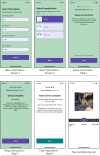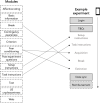Introducing the Fear Learning and Anxiety Response (FLARe) app and web portal for the remote delivery of fear conditioning experiments
- PMID: 36070129
- PMCID: PMC10556157
- DOI: 10.3758/s13428-022-01952-y
Introducing the Fear Learning and Anxiety Response (FLARe) app and web portal for the remote delivery of fear conditioning experiments
Abstract
Experimental paradigms measuring key psychological constructs can enhance our understanding of mechanisms underlying human psychological well-being and mental health. Delivering such paradigms remotely affords opportunities to reach larger, more representative samples than is typically possible with in-person research. The efficiency gained from remote delivery makes it easier to test replication of previously established effects in well-powered samples. There are several challenges to the successful development and delivery of remote experimental paradigms, including use of an appropriate delivery platform, identifying feasible outcome measures, and metrics of participant compliance. In this paper, we present FLARe (Fear Learning and Anxiety Response), open-source software in the form of a smartphone app and web portal for the creation and delivery of remote fear conditioning experiments. We describe the benefits and challenges associated with the creation of a remote delivery platform for fear conditioning, before presenting in detail the resultant software suite, and one instance of deploying this using the FLARe Research infrastructure. We provide examples of the application of FLARe to several research questions which illustrate the benefits of the remote approach to experiment delivery. The FLARe smartphone app and web portal are available for use by other researchers and have been designed to be user-friendly and intuitive. We hope that FLARe will be a useful tool for those interested in conducting well-powered fear conditioning studies to inform our understanding of the development and treatment of anxiety disorders.
Keywords: Classical conditioning; Fear conditioning; Online research; Pavlovian conditioning; Remote testing; Smartphones.
© 2022. The Author(s).
Conflict of interest statement
None to declare
Figures




Similar articles
-
Validating the use of a smartphone app for remote administration of a fear conditioning paradigm.Behav Res Ther. 2019 Dec;123:103475. doi: 10.1016/j.brat.2019.103475. Epub 2019 Sep 12. Behav Res Ther. 2019. PMID: 31639526 Free PMC article.
-
The role of associative fear and avoidance learning in anxiety disorders: Gaps and directions for future research.Neurosci Biobehav Rev. 2018 May;88:117-140. doi: 10.1016/j.neubiorev.2018.03.015. Epub 2018 Mar 14. Neurosci Biobehav Rev. 2018. PMID: 29550209 Review.
-
A behavioural neuroscience perspective on the aetiology and treatment of anxiety disorders.Behav Res Ther. 2014 Nov;62:24-36. doi: 10.1016/j.brat.2014.08.012. Epub 2014 Sep 10. Behav Res Ther. 2014. PMID: 25261887 Review.
-
Evidence for distinct genetic and environmental influences on fear acquisition and extinction.Psychol Med. 2023 Feb;53(3):1106-1114. doi: 10.1017/S0033291721002580. Epub 2021 Sep 3. Psychol Med. 2023. PMID: 34474701 Free PMC article.
-
The next frontier: Moving human fear conditioning research online.Biol Psychol. 2023 Nov;184:108715. doi: 10.1016/j.biopsycho.2023.108715. Epub 2023 Oct 16. Biol Psychol. 2023. PMID: 37852526 Review.
References
Publication types
MeSH terms
Grants and funding
LinkOut - more resources
Full Text Sources

